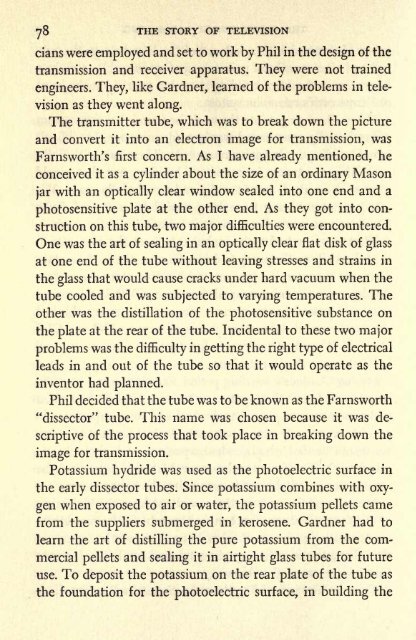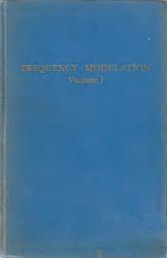the life of Philo T Farnsworth - Early Television Foundation
the life of Philo T Farnsworth - Early Television Foundation
the life of Philo T Farnsworth - Early Television Foundation
Create successful ePaper yourself
Turn your PDF publications into a flip-book with our unique Google optimized e-Paper software.
y8<br />
THE STORY OF TELEVISION<br />
cians were employed and set to work by Phil in <strong>the</strong> design <strong>of</strong> <strong>the</strong><br />
transmission and receiver apparatus. were not trained<br />
They<br />
engineers. They, like Gardner, learned <strong>of</strong> <strong>the</strong> problems in television<br />
as <strong>the</strong>y went along.<br />
The transmitter tube, which was to break down <strong>the</strong> picture<br />
and convert it into an electron image for transmission, was<br />
<strong>Farnsworth</strong>'s first concern. As I have already mentioned, he<br />
conceived it as a cylinder about <strong>the</strong> size <strong>of</strong> an ordinary Mason<br />
jar with an optically clear window sealed into one end and a<br />
photosensitive plate at <strong>the</strong> o<strong>the</strong>r end. As <strong>the</strong>y got into construction<br />
on this tube, two major<br />
difficulties were encountered.<br />
One was <strong>the</strong> art <strong>of</strong> sealing in an optically clear flat disk <strong>of</strong> glass<br />
at one end <strong>of</strong> <strong>the</strong> tube without leaving stresses and strains in<br />
<strong>the</strong> glass that would cause cracks under hard vacuum when <strong>the</strong><br />
tube cooled and was subjected to varying temperatures. The<br />
o<strong>the</strong>r was <strong>the</strong> distillation <strong>of</strong> <strong>the</strong> photosensitive substance on<br />
<strong>the</strong> plate at <strong>the</strong> rear <strong>of</strong> <strong>the</strong> tube. Incidental to <strong>the</strong>se two major<br />
problems was <strong>the</strong> difficulty in getting <strong>the</strong> right type <strong>of</strong> electrical<br />
leads in and out <strong>of</strong> <strong>the</strong> tube so that it<br />
would operate as <strong>the</strong><br />
inventor had planned.<br />
Phil decided that <strong>the</strong> tube was to be known as <strong>the</strong> <strong>Farnsworth</strong><br />
"dissector" tube. This name was chosen because it was de-<br />
down <strong>the</strong><br />
scriptive <strong>of</strong> <strong>the</strong> process that took place in breaking<br />
image for transmission.<br />
Potassium hydride was used as <strong>the</strong> photoelectric surface in<br />
<strong>the</strong> early dissector tubes. Since potassium combines with oxygen<br />
when exposed to air or water, <strong>the</strong> potassium pellets<br />
came<br />
from <strong>the</strong> suppliers submerged<br />
in kerosene. Gardner had to<br />
learn <strong>the</strong> art <strong>of</strong> distilling <strong>the</strong> pure potassium from <strong>the</strong> commercial<br />
pellets<br />
and sealing it in airtight glass tubes for future<br />
use. To deposit <strong>the</strong> potassium on <strong>the</strong> rear plate<br />
<strong>of</strong> <strong>the</strong> tube as<br />
<strong>the</strong> foundation for <strong>the</strong> photoelectric surface, in building <strong>the</strong>











